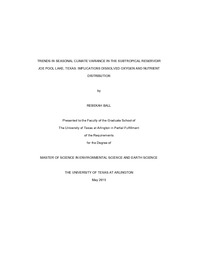| dc.description.abstract | The primary causes of seasonal variance in temperature, hydrological cycle, and nutrient distribution of lakes, and the processes explaining these changes including climate change and land use changes have been investigated for several decades because the importance of lakes for water resources, recreation, and sensitive ecosystems. Many of the previous studies, however, have been focused predominately on natural lakes in temperate climates and not on subtropical reservoirs. In this study a seasonal survey of temperature, turbidity, dissolved oxygen, and nutrients on the Joe Pool reservoir in North Central Texas has been conducted almost weekly from November 21st of 2012 through November 20th of 2013 and compared with meteorological data from the National Weather Service and Western Regional Climate Center and with previous seasonal lake measurements. Measured lake temperatures during sampling ranged from 6.5 °C in winter to 30.0°C in summer. Lake mixing was enhanced during spring and fall with wind speeds exceeding 5 m s-1 due to frontal systems and thunderstorms leading to uniform vertical oxygen and nutrient distribution. During May to June, increased solar radiation leads to increases in air and lake surface temperatures, thus increasing the vertical thermal gradient and stratification in the lake. Dissolved oxygen declines during these months and soluble reactive phosphorus increases in response to these physical changes. The amplitude of the seasonal cycle decreased compared to surveys from 1991 through 1992 and from 1999 through 2001, potentially attributed to long-term fluctuations in climate that are likely attributed to climate variability, such as Mt. Pinatubo eruption and ENSO, and long-term climate change. Since the impoundment of water into Joe Pool Lake in 1986, nutrient concentrations decreased through time potentially due to reservoir aging. | en_US |

